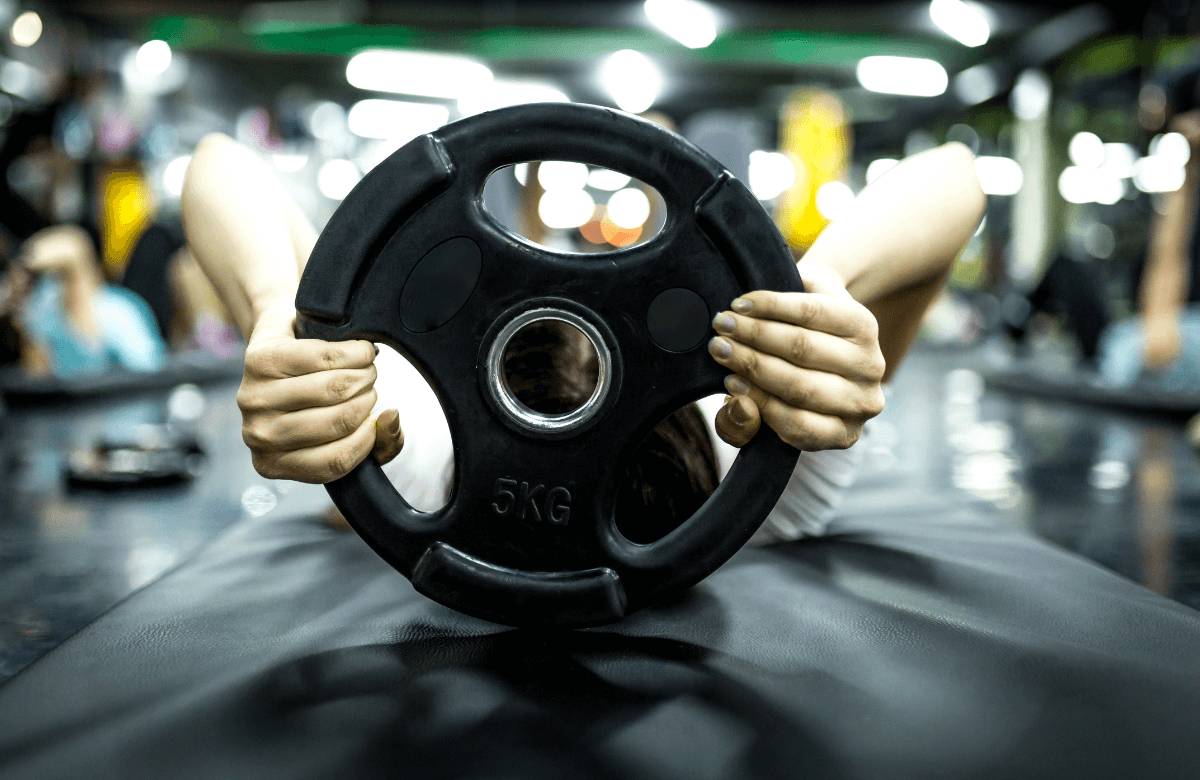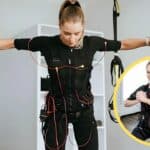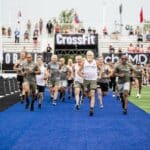Having a chiseled chest is most men’s and women’s dreams, so you need to get creative in looking for the best exercises to give you the looks you’re craving. If that’s your case, keep reading.
This article will cover the Plate press: technique, benefits, and muscles working. You’ll learn everything you need about the plate press to take your chest gains to the top level.
Without further to do, let’s dive in!
Jump to:
What Is The Plate Press?
The plate press is a chest isolation exercise that requires a lightweight plate to press against, creating the contraction of the pec muscles in conjunction with other secondary muscles.
Many people use it as a supplemental or chest accessory exercise to complement their chest day workouts. Even if you don’t have plates, you can hold a dumbbell at chest level and get the same benefits.
You can also do it on your feet, seated, or lying flat on a bench. Easier to learn and with very low injury risk.
How To Do The Plate Press: Form & Technique
The pinch plate press is an exercise with low injury risk and is easy to learn and perform by almost anyone. With only four steps, be ready to put chest mass on your frame.
1) Grab 1 to multiple plates and press against them with your palms while keeping your feet shoulder width.
2) Hold the plates in the front and middle of your chest.
3) Extend your arms forward while contracting your chest as hard as possible.
4) Hold the position for 2-3 seconds and return to the starting position.
The entire movement is perfect as a supplement to your standard chest workout. You’ll rapidly notice muscle mass gain if you keep a constant tension.
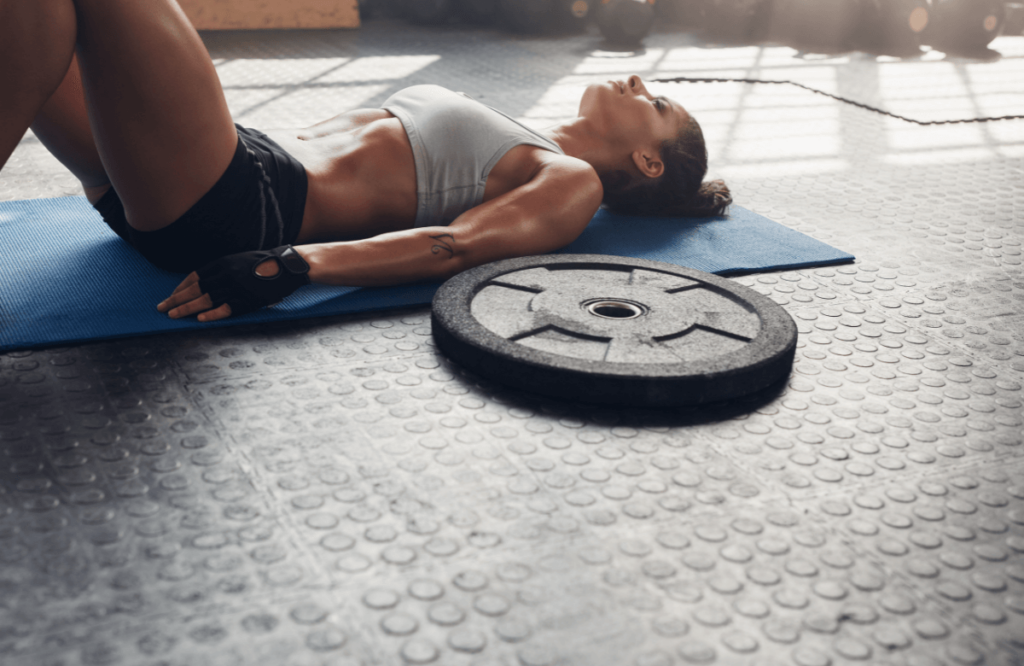
Plate Press: Muscles Worked
Although the plate press is a chest development exercise, other secondary muscle groups are involved and benefit from this movement.
Chest
The chest muscles are the primary muscle group targeted by the plate press. These are a fan-shaped group conformed of two portions:
– Pectoralis major
– Pectoralis minor
These two portions have three heads combined, the clavicle, sternal, and costal heads. The primary function of the chest is to adduct the arms (bring them closer together), although they also internally rotate the humerus and play a role in flexing the shoulder.
The plate press recruits an essential portion of these primary muscles without compromising the shoulder joint, making it a terrific option for many people.
Shoulders
The shoulders are the most mobile joint in the human body. It can move through a 360-degree motion with relative ease. There are many muscles responsible for stabilizing the joint, but the primary muscle group is conformed by:
– Anterior deltoid
– Medial deltoid
– Posterior deltoid
These three muscles are mainly responsible for flexing, abducting, and extending the shoulder joint. The plate press explicitly targets the anterior deltoid (shoulder flexion), which keeps the weight plate chest level while performing the movement.
Biceps & Forearms

The biceps are responsible for flexing the elbow joint through the biceps brachii (long and short head), while the forearms muscle group is in charge of flexing and extending the wrist while also pronating and supinating the forearms.
A crucial part of the plate press is holding the plate in front of the body, partly from the biceps action to bend the elbow slightly and the forearm’s role in flexing the wrist to press against the weighted plate.
Although this wouldn’t be considered a biceps nor forearms exercise, the muscle recruitment is evident and worth mentioning.
Traps
The trapezius, also known as “traps,” is a broad, thick muscle group conformed of three portions:
– Upper portion
– Medial portion
– Lower portion
Each portion plays a role in stabilizing the shoulder joint while providing room for a safe range of motion from the scapulae. The plate press recruits fibers from the upper portion of the trapezius.
They are fired during the weight plate hold, so many people report sore traps after trying the plate press for the first time (even with lighter weight.)
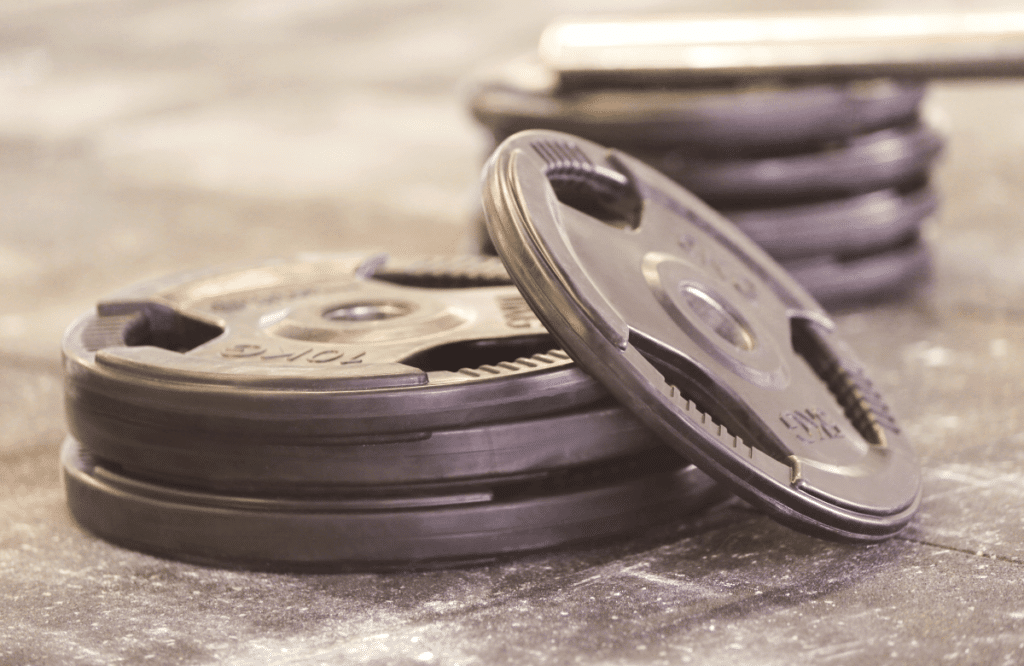
Plate Press: Benefits
As an isolation movement, the plate press has many benefits besides muscle gain. Below are four of the most important ones.
1. Isolates Chest Muscles
Unlike other chest exercises like bench or dumbbell press, the plate press isolates the chest muscles very well since it removes the shoulder flexion and triceps extension from the movement pattern.
This alone emphasizes the chest muscle fibers (great for muscle hypertrophy) without worrying about your shoulders or triceps getting tired and compromising the gains.
2. Great Variation For Injured Shoulders
One movement that tends to hurt the shoulder joint the most is flexion (raising arms). Since the plate press does not include this movement pattern, it is an excellent exercise variation for those with a history of injured shoulders.
3. Beginner Friendly
Many beginners are reluctant to go to the gym because they are scared of all the exercises they don’t know how to do, and it’s hard to blame them.
Luckily, the plate press is a beginner-friendly exercise that will take away that fear and complement any workout program.
4. Minimal Equipment
One of the best parts of including the pinch press in your regular workout routine is the ease of accessibility and the minimal equipment requirement.
This benefit makes it a terrific choice for those who don’t have access to regular gyms or who are always on travel for different reasons. You only need one (or 2-3 plates) plate or a single dumbbell, and you’re set to set your pecs on fire.
Plate Press: Variations
A positive feature of the plate press is the multiple alternatives it has to achieve the same result. Whether standing, seated, lying on a bench, or using a DB instead of a plate, these variations will keep you on track to get what you want.
Standing DB Pinch Press

The standing DB pinch press offers an alternative for those who don’t have access to plates and might want to use dumbbells instead. The mechanics and principles of the movement remain the same, although some individuals have reported more forearm recruitment with the dumbbells.
Seated Plate Press
The seated plate press variation is your solution if you hyperextend the back while pressing. You remove the hips’ ability to tilt and hyperextend the spine anteriorly by seating.
It is also a good alternative for seniors with lower body limitations who can’t stay on their feet for long.
Lying Plate Press
The lying variation is one of the most utilized because it takes stress off the shoulders and focuses almost exclusively on the pecs (which is what we’re looking for.) This alternative is particularly attractive for individuals with a history of shoulder injuries.
The movement is virtually the same as the standing variation, the only difference being that it starts with you lying with your back on the bench. This modification allows you to use heavier weights compared to any other because your shoulders won’t have to bear the load.
Beginners and seniors can benefit from the lying plate press.
Common Mistakes
The plate press is an easy movement to master with a low injury risk; however, you should avoid some common mistakes to maximize the benefits.
Weight Too Heavy
Using heavier loads than your body can handle safely is one of the most dangerous mistakes you could make for any movement. The plate press relies heavily on the front delts and biceps to keep the arms straight and upfront. Too heavy will put too much stress on the joints, which could increase the risk of injury.
If you’re starting, build up from a very low and manageable weight until your body can handle heavier loads safely. This will also help you master the form and technique of the movement.
Moving Too Fast
An essential element for muscle growth is increasing muscle time under tension. Tension creates stress on the muscle tissue, eventually pushing the body to adapt and grow stronger.
Moving the weights too fast will take away this critical stimulus and all its benefits, leaving a big chunk of the gains on the table. Instead, choose a weight that allows you to move slowly and control. Double down on contracting the muscle through the entire range of motion.
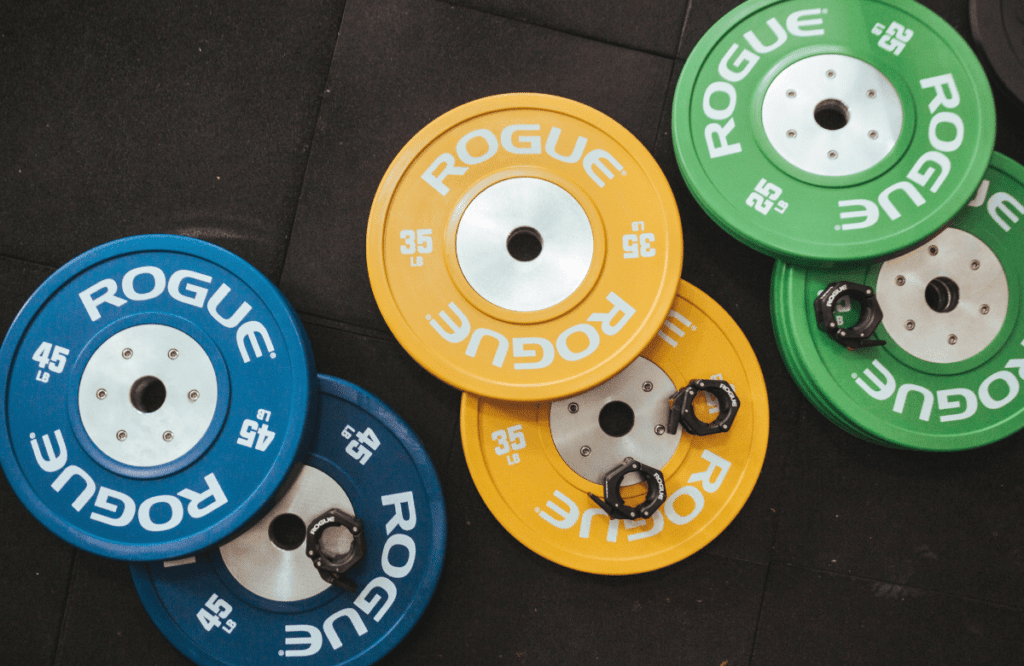
Short Range Of Motion
One of the silent killers of muscle growth is a short range of motion (ROM.) The bigger the ROM, the more fiber recruitment there is and the more time under tension those fibers get.
If you want to get the most out of this exercise, aim to increase your ROM by decreasing the weight or finding a variation that meets your current fitness level.
However, if you’re currently going through a shoulder injury and you’re building up some momentum, starting with a short range of motion can be beneficial until your muscles and joints get used to the stimulus.
Frequently Asked Questions
What Muscles Does Plate Press Work?
Plate presses work primarily the chest muscles, especially the inner portion (sternal fibers.) On top of that, they also work the front delts, upper traps, and forearms.
Do Plate Build Forearms?
Yes, the plate press builds forearms. Although they’re not the primary muscles, this exercise targets them slightly. For some individuals, having weak forearms may become a limitation for getting the most out of the plate presses.
Does Plate Press Work?
Yes, plate presses do work for building the chest muscles, especially the inner portion (sternal fibers.) Most people use them as a warm-up or at the end of the workout to squeeze in more volume. Individuals with shoulder injuries may also benefit from this exercise since it doesn’t require shoulder flexion, and the movement is limited.



